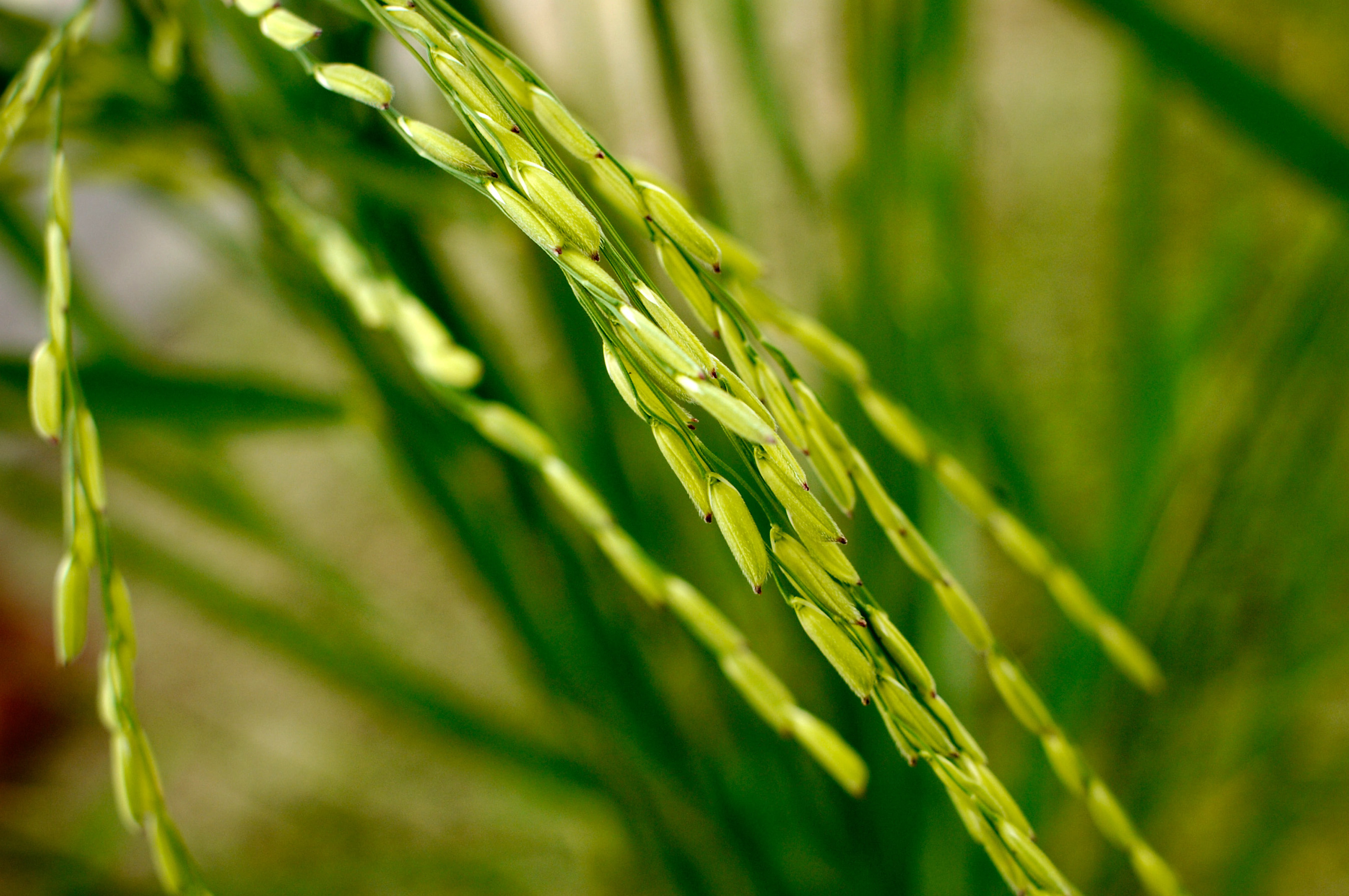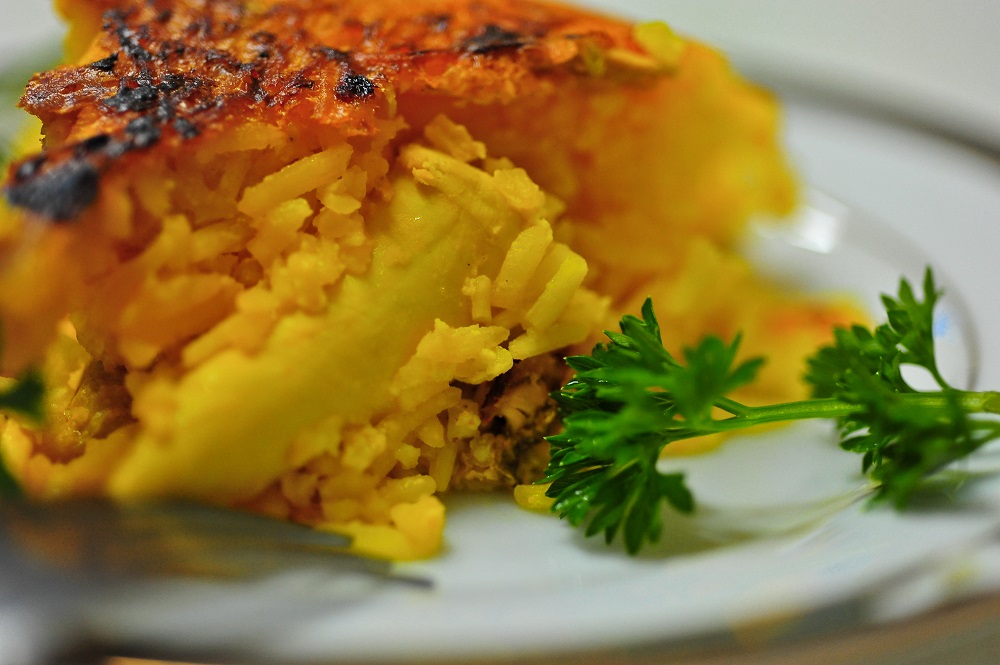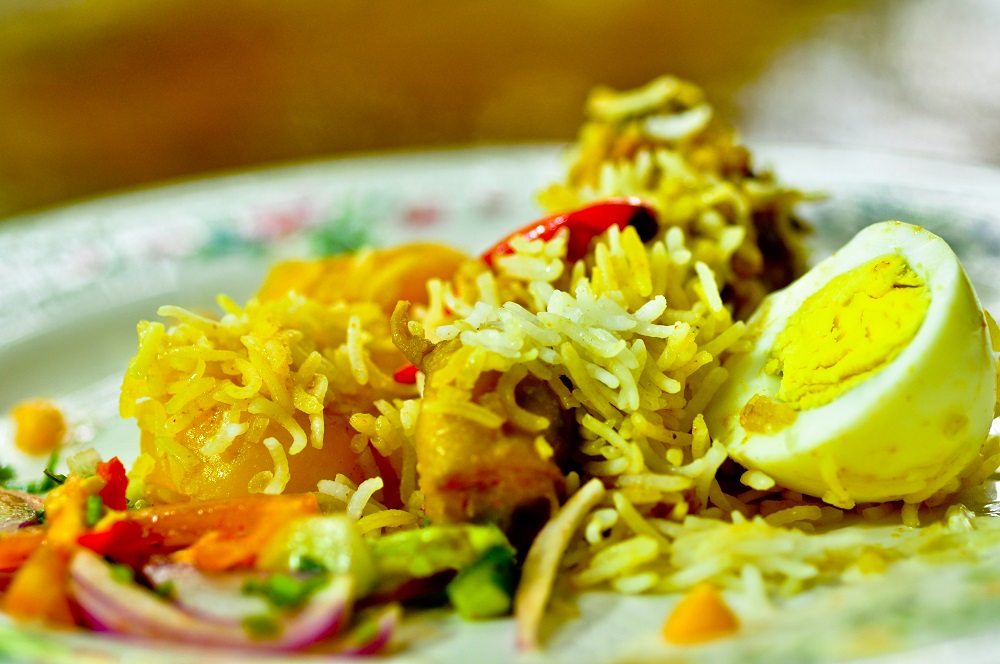
A panicle of traditional basmati (Basmati 370) cultivated in Ranbir Singh Pura and adjoining villages in the Jammu region. (Photo: IRRI)
.
Aromatic rice has been cherished for centuries for its flavor but mainly for its exquisite scent that makes it extraordinarily appetizing when cooked. In her book, Starting from scratch: memoirs of a wandering cook, Patty Kirk described the fragrance of aromatic rice as:
A low nose smell, more a suspicion than an identifiable fragrance, actually—an anticipation. It is like the smell of homemade bread that your lover is about to make for you or the brief elusive scent of a field of forget-me-nots when you are almost, but not quite, upon them. Good rice smells like rain in the summer air, just before it pours down.
For many, the distinctive bouquet of aromatic rice is deeply ingrained in their kitchens and their culture.
The trail of the scent
All aromatic rice varieties carry recessive genes that make them fragrant. These aroma genes have different variations or alleles. Scientists have identified several alleles linked to this important trait. The predominant allele in virtually all known fragrant rice varieties is badh2. The genes may have evolved in a genetically isolated population or been produced through selection during the domestication of rice by early farmers. Some researchers have traced the origins of aromatic rice varieties to a common ancestor in the sub-Himalayan region.
Farmers helped spread this trait across Asia because aromatic varieties are highly prized as aroma greatly determines the market value of rice. These rice varieties with the aroma genes were passed on from one generation to another and across geographical boundaries.
The International Rice Genebank at the International Rice Research Center (IRRI) has cataloged 843 traditional varieties of aromatic rice found in Asia: Afghanistan (1), Bangladesh (42), Bhutan (16), Cambodia (13), China (21), Indonesia (83), India (138), Iran (16), Japan (4), Korea (3), Lao PDR (84), Malaysia (35), Myanmar (111), Nepal (28), Pakistan (72), Philippines (73), Sri Lanka (9), Thailand (32), and Vietnam (53). In addition, there are aromatic rice varieties in Haiti (2), Madagascar (1), Tanzania (1), and the U.S. (3). There are two varieties of unknown origins.
Rice royalty
Although aromatic rice accounts for only 15% to 18% of the total global market, it commands the highest price of any variety of rice grown in the world. The international aromatic rice market is dominated by Thailand’s jasmine rice. But, it is basmati rice that has been hailed as the “queen of perfumed rice.”
In Hindi, basmati means “full of aroma,” although others say the name means “queen of fragrance.” It is not known how its name came into being but the earliest recorded usage of basmati was in 1766 by renowned Punjab poet Varies Shah in his epic poem Heer and Ranjha (see Thakrar R, Ahuja SC. 1990. Potential prospects for export of Basmati rice. In: Muralidharan K, Siddiq EA, editors. New Frontiers in Rice Research. DRR (ICAR), Hyderabad, India. p 382−387).
The origin of the rice itself has also not been established. However, long-grain rice was discovered in archeological excavations in Arhar Village, near Udaipur in the Indian state of Rajasthan. The rice dates back to 2000 BC to 1600 BC and is believed to be a possible ancestor of the beloved basmati.
Basmati rice has been cultivated in the foothills of the Himalayan region for thousands of years and has served as a staple on the royal menus of the maharajahs of the Indian subcontinent, the sultans and shahs in middle eastern Asia, and the ancient Mediterranean states.
In the modern era, basmati rice gained global fame in the 19th century through British and Portuguese traders. In India, the world’s leading exporter of basmati rice, it is primarily produced in the states of Jammu and Kashmir, Himachal Pradesh, Punjab, Haryana, Delhi, Uttarakhand, and Uttar Pradesh. In 2016, India exported more than 44 million tons of the rice, valued at over USD 4. 7 billion in 2018-2019.

Tah Chin saffron basmati rice and chicken. See recipe. (Photo by Isagani Serrano, IRRI)
.
Food for the body and soul
Basmati rice has a very distinct aroma, flavor, and texture. Its aroma has been described as similar to popcorn. Its flavor is sweet, nutty, and similar to pandan (an aromatic herb, Pandanus amaryllifolius, widely used in Asian cooking). Basmati adds a rich and complex layer of sensory quality to dishes. The cooked grains are long and slender, firm, and with a dry texture that does not stick together. Producers of basmati allow the paddy to age for at least one year to reduce its moisture content as this improves the firmness and elongation of the grains when cooked.
According to an Ayurvedic treatise that goes back to the 15th century, basmati is classified as saatvic. Saatvic foods are light and easy to digest. They bring clarity of mind, give a feeling of contentment, and bring out love and compassion in people. Meanwhile, modern science has determined that basmati has a medium glycemic index (GI), which means that consumption of this rice results in moderate fluctuations in blood sugar levels. For people with metabolic problems, basmati is a healthier choice than other rice varieties with higher GI.
“Cowboy” basmati vs. Indian basmati
Because of basmati’s high value, RiceTec, a Texas-based company, developed crosses between American long-grain rice and basmati rice. The company then applied for, and eventually was awarded, ownership of “Basmati Rice Lines and Grains” by the U.S. Patent Office in September 1997. This patent gave RiceTec exclusive rights to any basmati and basmati-like rice grown anywhere in the western hemisphere. In effect, the patent jeopardized exports of basmati rice to the U.S. and other western countries, causing enormous economic losses for Indian and Pakistani rice farmers.
The claims of ownership of the basmati name created a wave of protests and judicial challenges from the Indian government, that sought to protect its country’s natural produce from marketing misrepresentation, as well as nongovernment organizations in the U.S. and Canada that accused RiceTec of biopiracy.
India claimed that basmati is a variety of rice grown in the sub-Himalayan regions of India and Pakistan and its characteristics came from the unique agro-climatic conditions of the region and could not be found in the same variety grown elsewhere.
“The composition of the aromatic volatile oils is highly dependent on the environment,” explained Ruaraidh Sackville Hamilton, former head of IRRI’s T.T. Chang Genetic Resources Center and International Rice Genebank. “The soil you grow it on, how you manage the crop, the climate, all affect the aroma. Try growing basmati in the Philippines. It’s nothing like the basmati you buy from India because this is the wrong place to grow it.”
The Indian government argued that basmati, like Champagne, Cognac, and Scotch whiskey, could not be used for products made outside specific regions. It added that the name basmati has unique cultural value to local communities in India and Pakistan.
“It’s sensible to have a ‘geographical indication’ form of protection on basmati,” Dr. Sackville Hamilton added. “It’s got to be the right variety, grown in the right place, and managed in the right way in order to generate the characteristics we prize.”
In 2002, RiceTec withdrew 15 of its 20 patent claims while the U.S. Patent Office ordered the company’s patent title changed to “Rice Lines Bas867, RT 1117, and RT1121.” Because RiceTec lost the right to call its rice products “basmati,” the company currently markets them as Texmati and Kasmati.

Sam’s Chicken Biryani with basmati rice. See recipe. (Photo: Marites Saucelo, IRRI)
.
Preparing a culinary treasure
Some cookbooks recommended washing the rice using cold water several times, followed by soaking for about 30 minutes in cold water prior to cooking. It can be cooked like pasta; it is placed in boiling water with a pinch of salt and a few drops of oil. Using a strainer, remove the water when the grains are tender. Put the rice in a pot. Add a dash of oil on the rice and add some water and cook over low heat. Steam until cooked.
It can also be boiled or steamed like other rice. Add about 1¾ parts water for one part of basmati rice in a pot with a tight lid or a rice cooker. Bring to a boil and then lower the heat. Let it simmer for 12−14 minutes before turning off the heat. Because the amount of water may vary depending on the variety of rice, its age, and other factors, experts recommend using a different brand of basmati rice and amount of water to find that perfect ratio.
With its inherent qualities, basmati rice is already perfect on its own. But, it can also be superbly enhanced with herbs, spices, nuts, vegetables, and even fruits. Whether it is served simply or as part of a banquet, basmati is poetry that you can eat!








Nowadays most of the brand sold the Basmati rice but no such taste present in anyone of them because all the brands packed the item in bags are polished. In our village area a panchyat ‘Dopta’ is well famous for cultivating basmati paddy and rice getting from the paddy cooked in any house distinctly indicated in nearby house that anywhere anyone cooked basmati. Then I only say that here spread such fragrance in nearby locality that tell about itself for its reconization. But now? What to say?